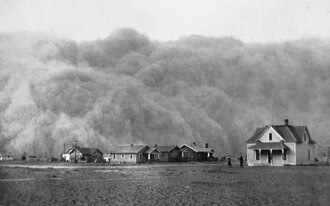Dust pneumonia

Editor-In-Chief: Prab R Tumpati, MD
Obesity, Sleep & Internal medicine
Founder, WikiMD Wellnesspedia &
W8MD medical weight loss NYC and sleep center NYC
| Dust pneumonia | |
|---|---|

| |
| Synonyms | Brown plague |
| Pronounce | N/A |
| Specialty | Pulmonology |
| Symptoms | Cough, dyspnea, chest pain, fever |
| Complications | Respiratory failure, pneumonia |
| Onset | Acute |
| Duration | Variable |
| Types | N/A |
| Causes | Inhalation of dust particles |
| Risks | Exposure to dust storms, poor air quality |
| Diagnosis | Clinical diagnosis, chest X-ray |
| Differential diagnosis | Pneumonia, asthma, chronic obstructive pulmonary disease |
| Prevention | Avoidance of dust exposure, use of respirators |
| Treatment | Supportive care, oxygen therapy, antibiotics if secondary infection |
| Medication | N/A |
| Prognosis | Variable, depends on severity and treatment |
| Frequency | Rare, associated with Dust Bowl era |
| Deaths | N/A |

Dust Pneumonia is a respiratory condition caused by the excessive inhalation of dust, leading to inflammation of the lungs. This condition was particularly prevalent during the Dust Bowl of the 1930s in the United States, where severe dust storms significantly impacted the health of the population in the Great Plains. Dust pneumonia can result from various sources of dust, including but not limited to, soil, silica, and industrial pollutants.
Causes and Risk Factors[edit]
The primary cause of dust pneumonia is the inhalation of fine dust particles into the lungs. These particles can come from natural sources, such as desert sand, or from human activities, such as mining, construction, and agriculture. Individuals at higher risk include those with prolonged exposure to dusty environments, the elderly, children, and those with pre-existing respiratory conditions like asthma or COPD.
Symptoms[edit]
Symptoms of dust pneumonia include persistent cough, difficulty breathing, chest pain, and in severe cases, cyanosis (bluish tint to the skin due to lack of oxygen). Additional symptoms may include fever, fatigue, and weight loss, indicating a systemic response to the inflammation in the lungs.
Diagnosis[edit]
Diagnosis of dust pneumonia involves a thorough medical history and physical examination, focusing on occupational and environmental exposure to dust. Diagnostic tests may include chest X-rays, which can show abnormalities in the lungs, and pulmonary function tests (PFTs) to assess the extent of lung damage. In some cases, a CT scan may be necessary for a more detailed view of the lungs.
Treatment[edit]
Treatment for dust pneumonia primarily involves removing the individual from the source of dust exposure and providing supportive care. This may include oxygen therapy for those experiencing difficulty breathing and medications to open breathing passages. In cases where an infection is present, antibiotics may be prescribed. Severe cases may require hospitalization.
Prevention[edit]
Preventive measures include minimizing exposure to dust through the use of protective equipment, such as masks or respirators, and improving air quality in work and living environments. Regular health check-ups are recommended for individuals at risk to monitor lung health and prevent complications.
Historical Context[edit]
The term "dust pneumonia" is often associated with the Dust Bowl era, a period of severe dust storms that damaged the ecology and agriculture of the American and Canadian prairies during the 1930s. The storms were caused by severe drought and failure to apply dryland farming methods to prevent wind erosion. The health impacts of these dust storms were devastating, with thousands suffering from dust pneumonia and other dust-related illnesses.
See Also[edit]
Ad. Transform your life with W8MD's Budget GLP-1 injections from $75


W8MD offers a medical weight loss program to lose weight in Philadelphia. Our physician-supervised medical weight loss provides:
- Weight loss injections in NYC (generic and brand names):
- Zepbound / Mounjaro, Wegovy / Ozempic, Saxenda
- Most insurances accepted or discounted self-pay rates. We will obtain insurance prior authorizations if needed.
- Generic GLP1 weight loss injections from $75 for the starting dose.
- Also offer prescription weight loss medications including Phentermine, Qsymia, Diethylpropion, Contrave etc.
NYC weight loss doctor appointmentsNYC weight loss doctor appointments
Start your NYC weight loss journey today at our NYC medical weight loss and Philadelphia medical weight loss clinics.
- Call 718-946-5500 to lose weight in NYC or for medical weight loss in Philadelphia 215-676-2334.
- Tags:NYC medical weight loss, Philadelphia lose weight Zepbound NYC, Budget GLP1 weight loss injections, Wegovy Philadelphia, Wegovy NYC, Philadelphia medical weight loss, Brookly weight loss and Wegovy NYC
|
WikiMD's Wellness Encyclopedia |
| Let Food Be Thy Medicine Medicine Thy Food - Hippocrates |
Medical Disclaimer: WikiMD is not a substitute for professional medical advice. The information on WikiMD is provided as an information resource only, may be incorrect, outdated or misleading, and is not to be used or relied on for any diagnostic or treatment purposes. Please consult your health care provider before making any healthcare decisions or for guidance about a specific medical condition. WikiMD expressly disclaims responsibility, and shall have no liability, for any damages, loss, injury, or liability whatsoever suffered as a result of your reliance on the information contained in this site. By visiting this site you agree to the foregoing terms and conditions, which may from time to time be changed or supplemented by WikiMD. If you do not agree to the foregoing terms and conditions, you should not enter or use this site. See full disclaimer.
Credits:Most images are courtesy of Wikimedia commons, and templates, categories Wikipedia, licensed under CC BY SA or similar.
Translate this page: - East Asian
中文,
日本,
한국어,
South Asian
हिन्दी,
தமிழ்,
తెలుగు,
Urdu,
ಕನ್ನಡ,
Southeast Asian
Indonesian,
Vietnamese,
Thai,
မြန်မာဘာသာ,
বাংলা
European
español,
Deutsch,
français,
Greek,
português do Brasil,
polski,
română,
русский,
Nederlands,
norsk,
svenska,
suomi,
Italian
Middle Eastern & African
عربى,
Turkish,
Persian,
Hebrew,
Afrikaans,
isiZulu,
Kiswahili,
Other
Bulgarian,
Hungarian,
Czech,
Swedish,
മലയാളം,
मराठी,
ਪੰਜਾਬੀ,
ગુજરાતી,
Portuguese,
Ukrainian
